Analysis of the Content
by Bertrand Puvis de Chavannes
Regrettably the rights of the heirs under French law were overlooked before the publication of Aimée Brown Price’s
catalogue raisonné.As the galley proofs were not submitted, the final approval could not be given ; therefore, the opportunity to provide scholars and art historians with the most complete reference book was missed. It would also have allowed errors, which were previously published in the Brown Price catalogue of the Pierre Puvis de Chavannes exhibition in Amsterdam in 1994, to have been corrected. (The corrections to that catalogue by the Pierre Puvis de Chavannes Committee are available on request.)
We are perplexed by Brown Price’s comments about the authentication of the artist’s works following his death. Despite the fact that in June 2002, we had given her a photocopy of the document “Division of Goods Among the Heirs of M. Puvis de Chavannes” which contains the information that Victor Koos and Paul Baudoüin, two of Puvis's favourite students who collaborated with him for over twenty years, had been appointed as experts in the paintings of Puvis. They were asked to authenticate the works by Puvis in the presence of Monsieur Hémard, auctioneer, commissioned by Me Delapalme, Puvis’ notary. (Victor Koos is the only Puvis student who figured in the artist’s will as a recipient of a life annuity.) So, Koos and Baudoüin seem to us to have been ideally situated to identify the works in the studio. Of the more than 140 canvases and 2000 drawings with the seal of succession, we only identified two drawings done by another hand; they were the works of the artist Louis Janmot (1814-1892).
We also regret that Richard Wattenmaker’s name is not indexed; in 1975 he organized an exhibition demonstrating the rôle played by Puvis de Chavannes in the development of modern art at the end of the 19th and the beginning of the 20th century. Serge Lemoine was also omitted; he, in a masterly manner, developed Wattenmaker’s original idea in his illuminating exhibition, De Puvis de Chavannes à Matisse et Picasso/Vers l’art moderne, which was presented in Venice in 2004. We regret as well that the name of François Blanchetière should not be mentioned in the Index as the author of the most enlightened entries written for the catalogue of the exhibition Puvis de Chavannes. Une voie singulière au siècle de l’Impressionnisme, shown in Amiens in 2005-06; nor the name of Bertrand Puvis de Chavannes whose information, directly or indirectly provided to the author, have allowed the inclusion of a significant number of works identified by him. We are equally surprised by the mere mention “Paris-Ottawa, 1976-77” as the constant reference to the work of Jacques Foucart and Louise d’Argencourt, both responsible for the organization of the seminal exhibition Puvis de Chavannes (Paris and Ottawa, 1976-77) and the main authors of the catalogue. It might have been fairer that their entries, individually signed, were referred to more specifically, and for the reader to understand whose ideas Brown Price is using or referring to in her discussions. We have still to remark here that other authors, discussed only in the notes, do not figure in the Index, however important their contributions. In doing so, Brown Price deprives her readers of indispensable references and full access to the bibliography relating to Puvis de Chavannes.
We mention here only the errors or shortcomings that we feel are
important. Numbers and titles refer to those in the catalog.
8 - Negro Boy.
This painting is no longer in private hands. Since 2008, it has been part of the collection of the Musée d’Orsay.
Emile Zola said of the works of the painter that “sobriety does not exclude the truth, and we sense the humanity beyond the symbol.” This viewpoint is not clearly understood by Brown Price. She expresses doubt as to the interpretation given to this painting; for Bertrand Puvis de Chavannes, this painting is a tribute to the abolition of slavery. The boy carries attributes of Mithras: youth, the sword, the Phrygian cap and a green cape. This Persian god was popular with soldiers and freed slave in Rome. The fires of insurgency burn in the background of this painting, dated 1850, just two years after the law permanently abolishing slavery. It is difficult not to see the intention. (In 1850 the struggle continued in Guadeloupe and Martinique, initiated by anti-abolitionists.) To see this painting solely as a work inspired by the warm tones of Delacroix does not credit the classical culture and humanity of the artist. Brown Price rightly compares the composition of this painting to that of L’Espérance, painted after the Franco-Prussian War. It is also certain that these two paintings are tributes to freedom: one bears the sword, the other an olive branch. The theme here chosen by the painter illustrates an idea dear to him.
13 - Portrait of Marc-Antoine Puvis de Chavannes.
This work is in a private collection in Saône-et-Loire, France. This portrait could have been inspired by that of the Count de Lasteyrie by Scheffer though portraits of prominent citizens in semi-profile were extremely common in the 1850s. It must be noted that Puvis' technique is radically different from that of Scheffer.
21 - Portrait of a Bearded Man
This work is supposed to come from the artist’s estate; however, there is no certifying seal on the reverse. This question suggests that it could be a fake but we have not seen the painting. This painting never belonged to any of the heirs of the artist
24 - Female Head.
This portrait in the collection of the Musée des Beaux-Arts in Algiers is of Marie-Antoinette de Vaugelas, sister of the painter. She bears a strong resemblance to her two children, Marguerite and Louis (cat. N°15 and N°16). First suggested by Louise d’Argencourt in the catalogue of the Puvis de Chavannes exhibition in Amiens 2005-06, N°168, it was later confirmed by Bertrand Puvis de Chavannes in a publication of the Pierre Puvis de Chavannes Committee. (See Parutions : « Marie-Antoinette de Vaugelas / Identification d’un portrait »).
)
64 - Bust of a Woman in Profile.
François Blanchetière in his note for this picture (See n° 62 in the catalogue of the exhibition Puvis de Chavannes. Une voie singulière au siècle de l’Impressionnisme , Amiens, 2005-06) seems accurate. The technique is that of the years 1860-62, very different from that of the 1854-55.
Related works:
N°64 a - The study of the three women's heads with braided hair has no link with this painting. It is a study for three works (cat. N°69 Julia, N°70 Julia Surprised, N°71 Julia, the daughter of Augustus…Surprised by Soldiers).
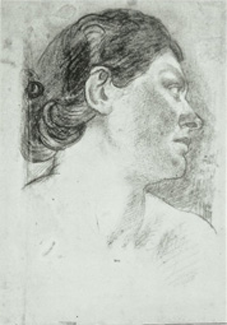
Not listed: large drawing inverted (France, private collection).
37 x 26 - Etude Femme de Profil
75 - Sketch for a Saint Sebastian.
This small painting executed with vivacity shows how Puvis was able to represent the same subject in different styles, several years apart. The Saint’s anatomy is treated here in a synthetic manner. The technique used, even more than the pose of the martyr, makes it unlikely that this painting is a preparatory work to the painting of 1857. François Blanchetière notes on this painting (Cf. Catalogue of the Puvis de Chavannes exhibition in Amiens, 2005-06, n°107) that it should be dated around 1865.
86 F - Christ with Tormentors.
See: Paintings by Pierre Puvis de Chavannes Unlisted in the Catalogue Raisonné, N°4.
90 - Portrait of the Artist’s Niece.
Information on the identity of the sitter, Sarah de Vangel, the niece of the artist, and on the present whereabouts of the painting, had been provided to Brown Price in response to her letter dated 29/01/2005: “(...) portrait of the artist’s niece: I am wondering if you could tell me its source. It is the portrait, I suppose, of Marguerite de V.”(Marguerite de Vaugelas, another niece of the artist).
93 - Young Woman on a Terrace, Venice.
It is not possible to authenticate a presumed oil of unknown size and location, known only through a black and white reproduction.
100 - Portrait of Baroness Lefebvre.
Related Works: drawing in private collection, France.
105 - Bellum

Related work: study - pencil, ink, watercolor on shalk paper.
18 x 26,5 cm.
Paris, Piasa, June 20th 2008.
Present whereabout unknown.
127 - Autumn (1864)
Related works: see N°6, in Bertrand Puvis de Chavannes, Paintings by Pierre Puvis de Chavannes Unlisted in the Catalogue Raisonné.
128 / 129 / 130 - Bathing Place / Cider / The River
Brown Price sees in these three paintings some preliminary works for the Ave Picardia Nutrix at the Amiens Museum. The River and Cider had been exhibited at Durand-Ruel in Paris, November, 1894 then in New York in December 1894 with the reference date of 1893. As Brown Price indicates these paintings are mentioned for the first time by Puvis in a note sent to Durand-Ruel in 1893. If they dated from the years 1864-65, how is it possible that these two superb paintings – now in the Metropolitan Museum– were not listed sooner in the Durand-Ruel’s archives? Why were they not exhibited earlier by Durand-Ruel or in another exhibition if one considers their undeniable aesthetic qualities as François Blanchetière says in his note (Catalog of the Puvis de Chavannes exhibition in Amiens, 2005-06, N° 86). Therefore, The River and Cider appear to be replicas, the technique (areas of flat colours, spare style) is different from that found in preparatory works painted by Puvis for this part of the Amiens decors (1865). It is impossible to find such light tones, pure colours, sharp contours in the works of the 1860s.
132 / 133 - Old People Planting an Olive Tree Helped by a Young Boy/ Sketch of Old Couple Walking Along a Road
In the exhibition of 1976-77, in Paris and Ottawa, Jacques Foucart dated these two paintings around 1870-75. Louise d’Argencourt in her entry for the first painting in the catalogue of the exhibition in Amiens 2005-06 (N° 112) also agrees that the pair should be dated later than Brown Price’s date of 1865-69. For stylistic reasons, François Blanchetière also places them at a later date.
140-La Fantaisie
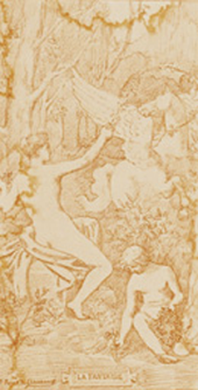
Related work :
sanguine - 37,4 x 23,3 cm
Signed lower left.
Lyon, private collection.
Christie’s, Londres,15/11/2006, n° 272
Present whereabout unknown.
141 - Vigilance
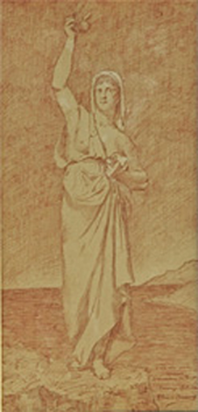
Related works:
Large red chalk signed and dedicated to his cousin Madame Du Rozet.
Private collection, France.
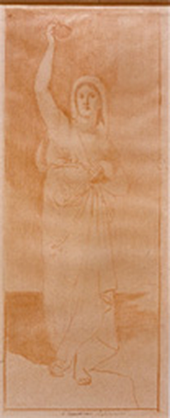
Small red chalk : 30 x 13 cm.
Signed and dedicated lower center: « à Monsieur Lehmann,Hommage bien cordial».
Toulouse, France, private collection.
143 - Concentration or Contemplation.
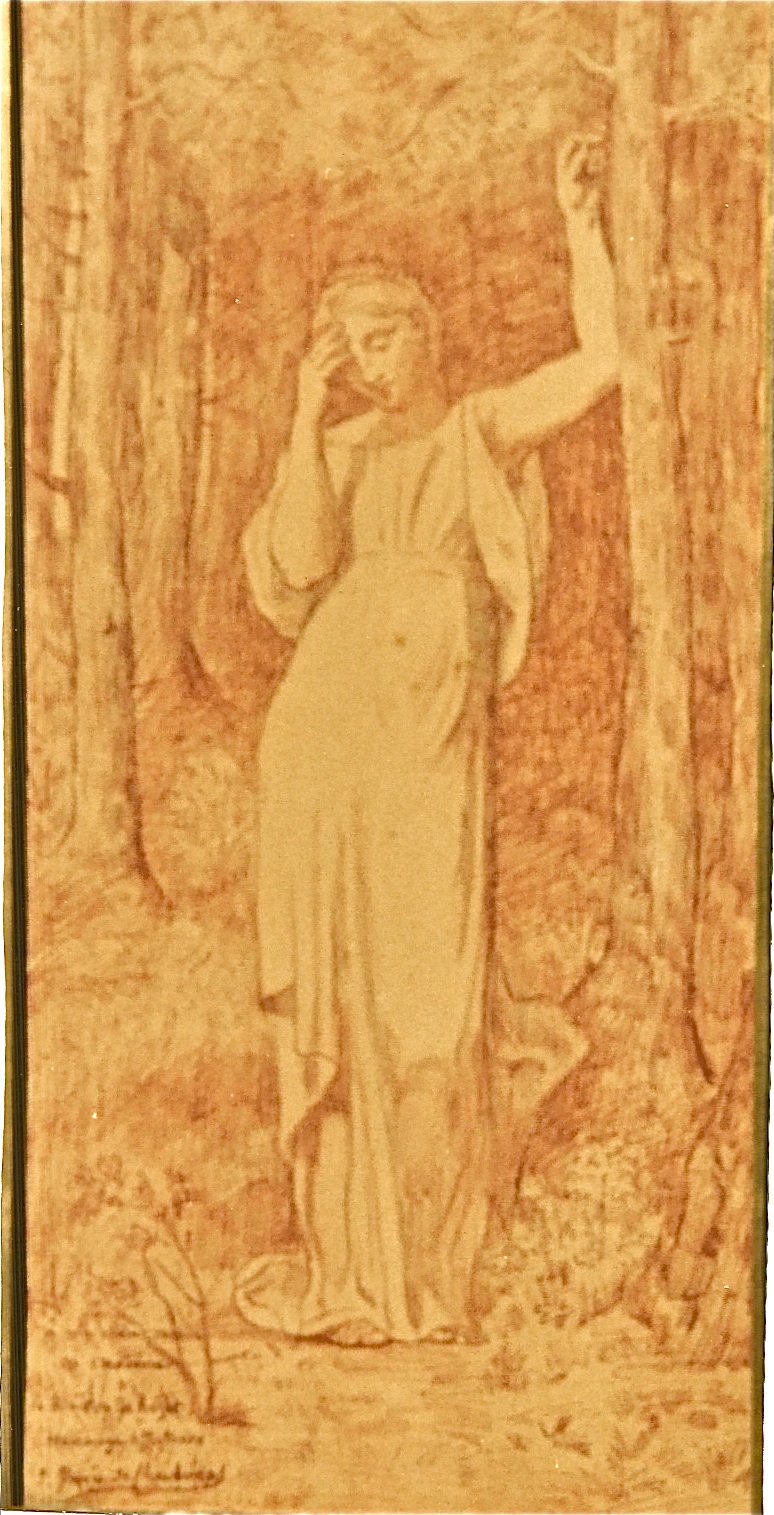
Related works:
Large red chalk - 58x28cm.
Also signed and dedicated to his cousin Madame Du Rozet.
Private collection, France.
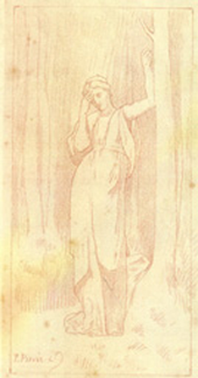
Small red chalk - 27x16cm. S.L.R.
Private collection, France.
145 - Vigilance
In 1994, we had already informed Brown Price of the problematic nature of the history that she had given to this painting in the catalog of the Puvis de Chavannes exhibition in Amsterdam. Coming from the estate, this work has remained in the possession of the family of heirs of Alphonse Puvis de Chavannes, Puvis's nephew and executor of the painter.
147a - Contemplation or Meditation or Reminiscence.
Upon examination of the reproduction there is a question about the authenticity of the original painting. The black and white reproduction of this unlocated Meditation suggests to us that the painting may not be by Puvis.
153 - Sketch for Paolo and Francesca
Brown Price notes that there is no reference number for this painting in the estate’s inventory. « Roméo et Juliette », a close subject, has two references: N° 99 and N° 120. In the absence of known versions of « Roméo et Juliette » and considering the similarity of the themes, we think that N°153 in Brown Price’s catalogue corresponds to N° 99 of the estate inventory, quoted at 90 francs, included in lot 2, allocated to the branch of the family where the Sketch for Paolo and Francesca (sic) comes from. N°120, quoted at 100 Francs, would be the final version; its location is unknown at present. The date given in the catalogue raisonné (ca 1867) seems too early. The medium and the technique are the same as those used in the small sketch for The Poor Fisherman (ca 1879), N° 264.
162 - Composition: A Processional (Study relating to Massilia, colonie grecque).
In her 1972 thesis (Yale University Press, N° 305), Brown Price compares this work to a painting on the ceiling for the main staircase in the City Hall in Paris, Victor Hugo (1894) and also to The Philosophy (1896), part of the decoration for the Boston Public Library. In 2002, Bertrand Puvis de Chavannes provided the documents that allowed this work to be identified as a sketch for Massilia, one of the two decorative panels in the Marseille Museum. Under N° 162 of the catalog, Brown Price is using Bertrand Puvis de Chavannes' information. Quoting in note 2, as well as in other notes that appear at the end and in the Index, Brown Price avoids giving him credit and acknowledgment.
165 - Massilia, Greek Colony.
Re: fig. N° 165a Semiramis Building Babylon: Serge Lemoine was the first to compare this painting by Degas with Puvis' work. (Cf also fig. 274a Degas’ Jeunes filles spartiates provoquant des garçons.)
169 - Head of a Saint or Saint John the Baptist.
The subject of this sketch was long thought to be a Saint Sebastian. The identification as a Saint John the Baptist was possible because of the link found by Bertrand Puvis de Chavannes to some drawings in Amiens Museum. His finding was endorsed by the Musée d’Orsay, which owns this painting. The incitation to work on the theme of Saint John the Baptist may have come from Puvis’ frequent stays in Amiens and visits to the cathedral from 1861 to 1865.
174 - La Madeleine au désert.
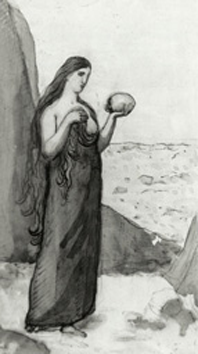
Related work:
Ink on paper - 31,5x21cm.
Stamp of the estate lower right.
Exhibition : Puvis de Chavannes / Un parcours singulier au siècle de l’impressionnisme, 2005-2006,n°109
Provenance: Estate of the artist/ Collection Daniel Malingue.
174b - La Madeleine au désert.
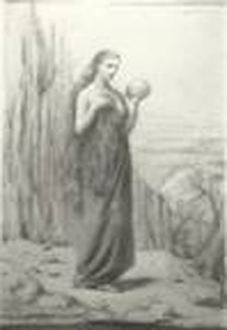
Pastel on paper
France, private collection
Provenance : estate de l’artiste
194 - Figures Bathing.
The image of the man rising out of the water (absent from the painting Summer of 1873) brings to mind Summer of 1891 (Hôtel de Ville, Paris).
244 - Saint Lazarus and the Two Saints Mary Landing in Provence - 1896-97
Dated by Brown Price circa 1876-77. This painting seems to be in connection with the decorations for L’Enfance de Sainte Geneviève (if only by its square size which exists only in the Pantheon). The style is nevertheless closer to that of the final years. It is not very probable that Puvis de Chavannes painted a sky so uniformly blue in 1876-77. Moreover, this painting was only shown to the public for the first time in 1899 at Durand-Ruel. One would ask why this magnificent work was not exhibited as part of the Puvis de Chavannes exhibition organised in 1887 by Durand-Ruel, or at another later exhibition, if it existed before 1896-97.
249 - A Farmer and His Wife with White Calf (fragment).
The wrong placement of the signature may indicate that it was added later.
255 - Jeunes filles au bord de la mer
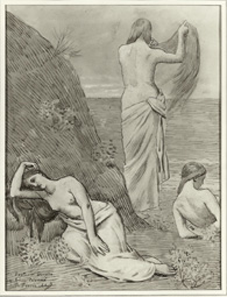
Related work:
Pencil on paper - 35,5 x 26,5 cm
Signed and dedicated lower left : « au Docteur Dupré / son bien dévoué : P.Puvis de »
Hambourg, Kunstalle
271 - Study of a Man’s Head for Le pauvre pêcheur.
The technique is very different from that of the years 1875-80, and the face is reminiscent of that of a model who had posed for Saint John the Baptist (1869) and many other drawings preserved in Amiens Museum.
274 - Ludus pro Patria
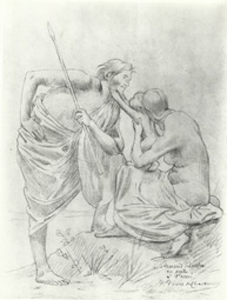
Pencil, 36 x 27 cm
Signed and dedicated lower right : « à Armand Silvestre / au poète / à l’ami / P.Puvis de Chavannes »
Alger, Musée des Beaux-Arts
289 - Ludus pro Patria

Provenance
Pau, vente Gestas, 24-07-2010
Londres, Galerie Stair Sainty
293 – Woman Leaning on her Elbow.
This version has been donated to the Musée d’Orsay by Mr. Daniel Malingue.
325-a and b - Studies
These two detailed studies are preliminaries for Ave Picardia Nutrix. The woman's face on the first is typical of Puvis’ work of the 1860s. The same small group of the second with the haystack can be found in a study for the composition preserved at Amiens.
335 - La Sorbonne
Related work:
Pastel on paper for La Botanique
50 ¼ x 29 ¼ inches
Minneapolis, Institute of Arts
Provenance : gift of James J. Hill
349 - Landscape Study
(relating to La Vision antique (sic) and Le Chant du berger). This is not a sketch for the painting The Shepherd’s Song (1891) at the Metropolitan Museum of Art, New-York. Rather, it can be compared to a part of the background at the center of Vision antique (Lyon Museum, 1885); the composition - with the presence of the tree - and the colour of the stone, are similar in both works. Consequently, this sketch must belong to an earlier period.
366 - Head of a Woman.
Brown Price dates this painting from the years 1893-95. The style of that period, the face and its tilt, are reminiscent of Flore's standing woman (1858).
416 - Virgile
Related work:
Red shalk on paper - 47 x 23,5 cm
Signed and dedicated lower left: « à Mademoiselle Sauvestre / Respectueusement / P.Puvis de Chavannes / 92 »
Suède, Lund University.
417 - Eshyle
Related work:
Watercolor on paper
417 a : 31 x 19,7 cm (cf detail).
France, private collection
Provenance : Estate of the artist
Related work:
Watercolor on paper
417 b : 25,7 x 23 cm
France, private collection
Provenance : Estate of the artist
Cat. A7 (p.428 ) - La Construction du temple.
In our opinion, this work is a sketch by Victor Koos, Puvis’ student, for La Pierre. The man bending over in the foreground of the sketch is identical to the one in the final version. One can here recognize Puvis de Chavannes, at the center, talking to an architect (Koos?). Koos' signature seems to have been erased. It is possible that Puvis’ signature, here, is of doubtful authenticity. Nevertheless, this sketch reminds us of three other paintings by Victor Koos, signed “P. Puvis de Chavannes” including the reproduction numbered A105 in the catalog. While Koos's signature has disappeared there too, a few verses from Genesis in Puvis’ handwriting appear on the black part of the canvas. An analysis of the writing was made at the request of the PPC committee by Mr Prot, expert in graphology at the court of Versailles, and he confirmed its authenticity. Finally, it should be noted that the joined signatures “P. Puvis de Chavannes” and “Victor Koos” can be clearly seen on a painting similar to those of this group.
Translated and edited by Lynne Suo, July 2011. London and
Paris.
|